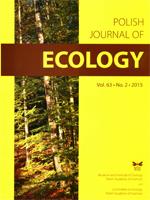The present study describes natural regeneration on five permanent research plots (PRP) in juvenile growth and development phases (regrowth and advanced growth) in autochthonous beech forests in Broumovské stěny National Nature Reserve located in the Protected Landscape area in the northeast part of Czech Republic. The stands of herb-rich beech forests were studied in the optimum to break-up stage. Natural regeneration was not evenly spaced but rather was clustered. Mean regeneration density ranged from 1,472 to 44,888 recruits per ha. European beech (Fagus sylvatica L.) made up 78.5–98.0% of all regeneration. Sycamore maple (Acer pseudoplatanus L.) was also relatively abundant. Regeneration dominance and abundance responded to the mature stand canopy, soil skeleton, microrelief, ground vegetation cover, and surface characteristics. The results suggest a relationship between recruit height and microrelief in 4 out of 5 PRPs. We found statistically significant differences in height of natural regeneration (F(2,18843) = 191.8, P <0.001) on mounds (74.0 cm), on slopes (119.5 cm) and on pits (121.0 cm) due to high soil skeleton content on mounds with numerous rock outputs, minimum amount of fine earth and lower water retention, both necessary for recruit growth. In addition to the character of microrelief, the growth of natural regeneration was negatively influenced by mature stand density and canopy indicators.
How to translate text using browser tools
1 June 2015
Effect of Tree Layer and Microsite on the Variability of Natural Regeneration in Autochthonous Beech Forests
Zdeněk Vacek ,
Stanislav Vacek ,
Vilém Podrázský ,
Lukáš Bílek ,
Igor Štefančík ,
Waren Keith Moser,
Daniel Bulušek ,
Jan Král ,
Jiří Remeš ,
Ivo Králíček
ACCESS THE FULL ARTICLE

Polish Journal of Ecology
Vol. 63 • No. 2
June 2015
Vol. 63 • No. 2
June 2015
close-to-nature stands
European beech (Fagus sylvatica L.)
microrelief
spatial pattern
species diversity
stand structure




